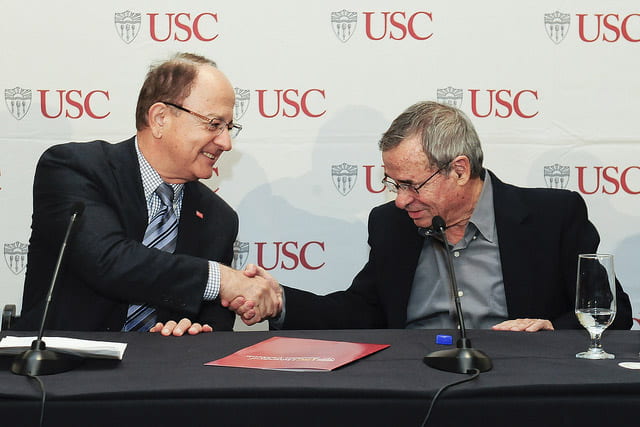Earlier this month, the USC community awakened to the exciting news that Distinguished Professor Arieh Warshel of our Dornsife College of Letters, Arts and Sciences was awarded the 2013 Nobel Prize in Chemistry. This was an extraordinary day for Professor Warshel and his family—and for USC. He shares this stellar distinction with two colleagues at other institutions, Harvard’s Martin Karplus and Stanford’s Michael Levitt, with whom he collaborated earlier in his career.
Professor Warshel joined USC’s faculty as an assistant professor in 1976, and this prestigious award reflects the university’s longstanding investment in research, particularly in science and technology. Professor Warshel has essentially spent his entire career at USC. Beginning in the 1970s, long before computers were commonplace, he and his colleagues created numerical simulations of molecules, which enabled them to examine these particles even more minutely and rigorously. This dramatically deepened our understanding of complex chemical reactions, such as combustion and photosynthesis, and has significantly improved the design of new drugs.
I warmly congratulated Professor Warshel and his family on the morning of the announcement, and joined him for his press conference in Town & Gown. Media filled the room, standing shoulder to shoulder with his many admiring colleagues and students. The excitement was palpable. In the weeks since, Professor Warshel’s work has generated tremendous international attention, and I will share this coverage in greater detail next month.
In addition to Professor Warshel’s Nobel Prize, USC faculty earned another outstanding accolade earlier this month. The State of Israel awarded the Eric and Sheila Samson Prime Minister’s Prize for Innovation in Alternative Fuels for Transportation to Distinguished Professor George Olah and Professor G. K. Surya Prakash, both faculty in our Dornsife College of Letters, Arts and Sciences. The $1 million prize recognizes their pioneering research in advancing methanol markets, and their longstanding work in developing viable alternatives to fossil fuels. USC has become a leader in this area, and I would like to share an op-ed that Professor Olah and Trustee Chris Cox recently published on this subject in The Wall Street Journal. It offers more information on the innovative research being carried out at the university.
Continuing on the subject of distinctions, two faculty at our Viterbi School of Engineering earned different, high profile recognitions earlier this fall. Popular Science included Professor Andrea Armani among this year’s Brilliant Ten, recognizing her passionate pursuit of innovation in diverse areas, as well as her contributions to scientific discovery, notably through sensors she has developed. These instruments function like an optical tuning fork, and may help detect extremely elusive traces of disease.
Also this fall, MIT Technology Review included Professor Hao Li among its prestigious list of Innovators Under 35. This special honor speaks to the groundbreaking qualities of his work on algorithms, as well as his exceptional leadership in his field. Professor Li’s innovations have numerous applications, and one is already being used in some medical radiation scanners, where it meticulously localizes a tumor as a patient breathes.
In October, the USC Shoah Foundation held its annual gala in New York City, at which it honored George Clooney with the Ambassador for Humanity Award. This special evening brought together nearly 800 supporters and researchers, all of whom are staunchly committed to the foundation’s important mission of remembering the Holocaust and other genocides. During the evening, USC Trustee Steven Spielberg, who established the foundation in 1994, praised Mr. Clooney’s humanitarian contributions, including his role in founding the Not on Our Watch project, which seeks to prevent future atrocities. The evening featured appearances by a number of celebrities, including Jon Stewart, Sandra Bullock, and Norah Jones—all of whom voiced inspired support for the Shoah Foundation’s noble work.
Finally, as I wrote in last month’s letter, Elton John visited USC and collaborated with the magnificently talented students in our Thornton School of Music. Their concert in Bovard Auditorium was such a tremendous success—and Elton John’s esteem for our students so considerable—that he asked them to perform with him at the Emmy Awards. Their musical collaboration generated a great deal of acclaim: Entertainment Weekly called it a “storytelling extravaganza,” and the Los Angeles Times praised Elton John’s “strength and precision.” We’ve gathered excerpts from this coverage, as well as some excellent photos, for you. As always, I truly appreciate your sharing USC’s news with your friends and family, and your continued service as a USC Ambassador.
Yours truly,
C. L. Max Nikias
President
